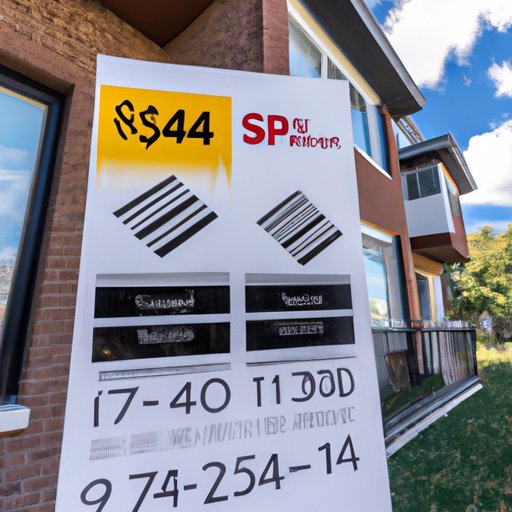Introduction
When it comes to setting fees for real estate photography services, there are a few key questions that need to be answered: How much should you charge? What factors should you consider when establishing rates? And how can you make sure you’re getting paid a fair rate for the services you provide? This article explores these questions in detail, providing an overview of the current market for real estate photography services, tips for setting rates that reflect your professional experience and skill level, and advice on offering discounts to encourage repeat clients.
Analyzing the Market: Researching What Other Photographers Charge for Real Estate Photography
The first step in determining what to charge for real estate photography is to analyze the market. By researching what other photographers in your area are charging for their services, you can get a better sense of what the going rate is for real estate photography. While this may not be the exact amount you should charge, it can give you a good starting point for setting your own rates.
When researching competitor’s fees, pay close attention to the type of services they are offering and the quality of their work. Do they offer a variety of services such as aerial photography, interior and exterior shots, or video tours? Are they using high-end equipment and post-processing software? Are they providing a professional and expedient service? All of these factors can help you determine what to charge for your services.

Establishing Rates Based on Your Own Professional Experience and Skill Level
Once you have a better understanding of the market, it’s time to start thinking about your own professional experience and skill level. Consider the types of projects you’ve worked on, the length of time you’ve been in business, and any awards or recognition you’ve received for your work. These things can all help you set rates that accurately reflect your level of expertise.
When it comes to setting prices, you have two main options: hourly rates and flat fees. If you’re just starting out, you may want to consider an hourly rate, which will allow you to charge more for jobs that require more time and effort. However, if you’ve been in the business for a while and have established yourself as a reliable and reputable photographer, you may want to consider a flat fee, which will enable you to offer a consistent rate for each job.

Understanding the Cost of Doing Business and Setting Reasonable Fees
In addition to your professional experience and skill level, you also need to consider the cost of doing business when setting your fees. This includes any expenses related to equipment (cameras, lenses, lighting, etc.), software, insurance, and travel. You should also factor in the amount of time it takes to complete a project, including setup, shooting, post-processing, and delivery.
By taking into account all of these costs, you can ensure that you’re setting reasonable fees that will cover your expenses and leave you with a profit. Additionally, you should keep in mind that the cost of doing business can vary depending on the size and scope of the project, so be sure to adjust your rates accordingly.

Calculating the Time Involved in Each Job to Determine the Right Price
Time is one of the most important factors to consider when setting fees for real estate photography. You need to estimate the number of shots needed for each project and the amount of time required for setup, shooting, and post-processing. This will help you determine how much time you need to allocate for each job and, in turn, the price you should charge.
For example, a basic shoot for a single-family home might take about three hours, whereas a large commercial property could take up to 10 hours. Knowing the time involved in each project will help you set a price that accurately reflects the amount of work required.
Offering Discounts to Encourage Repeat Clients
In addition to setting competitive rates, you should also consider offering discounts to encourage repeat clients. This can include special deals for regular customers, referral programs, or volume pricing. Offering discounts can help you build relationships with existing clients and attract new ones, ultimately helping you increase your profits.

Exploring Alternatives Such as Bulk Pricing or Package Deals
Another way to increase your profits is to explore alternatives such as bulk pricing or package deals. For example, you could offer discounts on multiple properties or create packages with set prices for different levels of service. This can help you save time and money by reducing the amount of time spent on each job, as well as making it easier to estimate costs and set fees.
Utilizing Online Tools to Help Set Appropriate Prices for Your Services
Finally, there are a number of online tools available that can help you set appropriate prices for your services. Automated pricing calculators and online scheduling platforms can streamline the process of estimating costs, setting fees, and booking appointments. These tools can save you time and help you stay organized, allowing you to focus on providing quality customer service.
Conclusion
Setting the right fee for real estate photography services can be a challenge, but with the right approach it can be done. Start by analyzing the market and researching what other photographers are charging for their services. Then, use your own professional experience and skill level to set rates that reflect the value of your work. Make sure to factor in the cost of doing business and calculate the amount of time involved in each job. Finally, consider offering discounts and exploring alternatives such as bulk pricing or package deals. With these tips, you’ll be able to determine the right fee for your services.
(Note: Is this article not meeting your expectations? Do you have knowledge or insights to share? Unlock new opportunities and expand your reach by joining our authors team. Click Registration to join us and share your expertise with our readers.)
